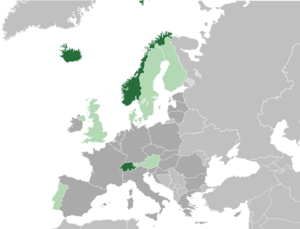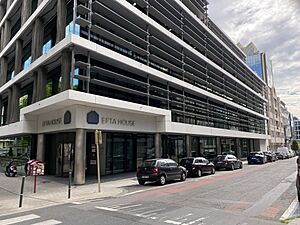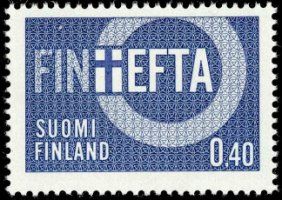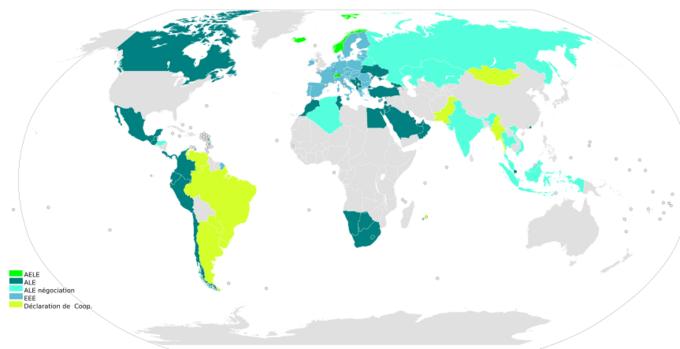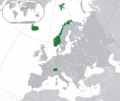European Free Trade Association facts for kids
Quick facts for kids
European Free Trade Association
Native names:
Association européenne de libre-échange (French)
Europäische Freihandelsassoziation (German) Fríverslunarsamtök Evrópu (Icelandic) Associazione europea di libero scambio (Italian) Eurohppá friddjagávpelihttu (Northern Sami) Det europeiske frihandelsforbund (Norwegian) Associaziun europeica da commerzi liber (Romansh) |
|
|---|---|

Location of the EFTA
|
|
| Secretariat | Geneva Brussels Luxembourg City 46°57′N 7°27′E / 46.950°N 7.450°E |
| Largest city | Oslo 59°56′N 10°41′E / 59.933°N 10.683°E |
| Official working language |
English |
| Official languages of member states |
|
| Type | Regional organization, Free-trade area |
| Member states | |
| Leaders | |
|
• Secretary General
|
Kurt Jäger |
|
• Council Chair
|
Iceland |
| Establishment | |
|
• Convention signed
|
4 January 1960 |
|
• Established
|
3 May 1960 |
| Area | |
|
• Total
|
528,618 km2 (204,101 sq mi) |
| Population | |
|
• 2025 estimate
|
15,073,574 |
|
• Density
|
28.5/km2 (73.8/sq mi) |
| GDP (PPP) | 2024 estimate |
|
• Total
|
$1.0 trillion |
|
• Per capita
|
$108,000 |
| GDP (nominal) | 2024 estimate |
|
• Total
|
$1.33 trillion |
|
• Per capita
|
$108,000 |
| Currency | |
| Time zone | |
|
• Summer (DST)
|
UTC+2 (CEST) |
| Note: Iceland observes WET all year, while Liechtenstein, Norway and Switzerland observe CET and CEST. | |
The European Free Trade Association (EFTA) is a group of four European countries that work together on trade. These countries are Iceland, Liechtenstein, Norway, and Switzerland. EFTA helps these countries trade freely with each other and with other parts of the world.
EFTA was created on May 3, 1960. It was an alternative for countries that didn't want to join the European Economic Community (EEC). The EEC was the main group at the time, and it later became the European Union (EU).
The first agreement to set up EFTA was signed in Stockholm, Sweden, on January 4, 1960. Seven countries, sometimes called the "Outer Seven," signed it. These were Austria, Denmark, Norway, Portugal, Sweden, Switzerland, and the United Kingdom.
Over time, many of the original EFTA members left to join the EU. By 1995, only Norway and Switzerland remained from the founding members. A new agreement, the Vaduz Convention, was signed in 2001 to help EFTA continue to grow trade.
EFTA countries can make their own trade deals with countries outside the group. However, they also work together to make trade agreements. Iceland, Liechtenstein, and Norway are part of the European Economic Area (EEA). This means they are part of the EU's single market, even though they are not EU members. Switzerland has its own special agreements with the EU.
Contents
EFTA Member Countries
A Look at EFTA's History
The European Free Trade Association was officially started on January 12, 1960. This agreement aimed to remove taxes on industrial products traded between members. However, it did not affect farm or fish products.
A key difference between the early EEC and EFTA was how they handled trade with non-member countries. EFTA members could set their own trade rules. The EEC, however, had common rules for all its members.
The first members of EFTA were Austria, Denmark, Norway, Portugal, Sweden, Switzerland, and the United Kingdom. These countries were known as the "Outer Seven." This was to distinguish them from the "Inner Six" of the European Economic Community.
Over the years, more countries joined EFTA. Finland became an associate member in 1961 and a full member in 1986. Iceland joined in 1970.
However, some countries also left EFTA. The United Kingdom and Denmark joined the EEC in 1973. Portugal also left EFTA to join the European Community in 1986. Liechtenstein joined EFTA in 1991. Austria, Sweden, and Finland joined the EU in 1995.
Norway has voted twice, in 1972 and 1994, against joining the EU. This means Norway has stayed in EFTA. Iceland applied to join the EU in 2009 but later decided not to.
Who Are the Current Members?
Today, EFTA has four member countries:
| Country | Joined EFTA | Population (2025) |
Area (km2) | Capital City |
|---|---|---|---|---|
| 1 January 1970 | 336,713 | 103,000 | Reykjavík | |
| 1 September 1991 | 37,910 | 160.4 | Vaduz | |
| 3 May 1960 | 5,337,962 | 385,155 | Oslo | |
| 3 May 1960 | 8,525,611 | 41,285 | Bern |
Past Members of EFTA
Several countries were once members of EFTA but later left, mostly to join the European Union.
| Country | Joined EFTA | Left EFTA | Joined EEC/EU |
|---|---|---|---|
| 3 May 1960 | 31 December 1994 | 1 January 1995 | |
| 3 May 1960 | 31 December 1972 | 1 January 1973 | |
| 1 January 1986 | 31 December 1994 | 1 January 1995 | |
| 3 May 1960 | 31 December 1985 | 1 January 1986 | |
| 3 May 1960 | 31 December 1994 | 1 January 1995 | |
| 3 May 1960 | 31 December 1972 | 1 January 1973 (left EU 31 January 2020) |
Other Countries and EFTA Membership
There have been talks about other countries joining EFTA. These include small European states like Andorra, San Marino, and Monaco. These countries have special relationships with the EU. Joining EFTA could help them be more connected to the EU's single market.
The United Kingdom left the EU in 2020. After this, some people suggested the UK could rejoin EFTA. This would allow the UK to still be part of the European single market. However, some EFTA members had concerns about a large country like the UK joining.
EFTA and the European Economic Area (EEA)
In 1992, the EU and EFTA countries signed an agreement to create the European Economic Area (EEA). This agreement allows EFTA countries to be part of the EU's European Single Market. This means they can trade freely with EU countries.
However, Switzerland voted against joining the EEA. Instead, Switzerland has many separate agreements with the EU. These agreements allow Switzerland to participate in the single market and the Schengen Agreement. The Schengen Agreement allows people to travel freely between countries without passport checks.
So, Iceland, Liechtenstein, and Norway are part of the EEA. They follow most EU laws related to the single market, but not laws about farming or fishing. They also help shape new laws.
Here's a simple look at how EU laws apply in EFTA countries:
| EFTA Countries | EU Law Applied | Schengen area | EU Single Market | Currency | |
|---|---|---|---|---|---|
| Partial | Yes | With exemptions, in EEA | ISK | ||
| Partial | Yes | With exemptions, in EEA | CHF | ||
| Partial | Yes | With exemptions, in EEA | NOK | ||
| Partial | Yes | With exemptions, sectoral agreements | CHF | ||
How the EEA Works
The EEA has a special committee called the EEA Joint Committee. This committee includes members from EFTA-EEA countries and the European Commission (from the EU). Their job is to make sure EU laws are also applied in the non-EU EEA countries.
The EEA also has its own court and a special authority. The EFTA Surveillance Authority checks that EFTA members follow their EEA rules. The EFTA Court makes sure these rules are understood and followed correctly. Switzerland is not part of these institutions because it is not an EEA member.
EEA and Norway Grants
The EEA and Norway Grants are financial contributions from Iceland, Liechtenstein, and Norway. These funds help reduce differences in wealth across Europe. They were set up when the EEA expanded in 2004. These grants help fund projects in 15 countries in Central and Southern Europe.
EFTA's Global Trade Deals
EFTA has many free trade agreements with countries outside the EU. These agreements help EFTA countries trade easily with partners around the world. EFTA has trade relationships with 40 different countries and regions.
Current Free Trade Agreements
EFTA has signed free trade agreements with many countries. Here are some examples:
- Albania (since 2010)
- Canada (since 2009)
- Chile (since 2004)
- Colombia (since 2011)
- Egypt (since 2007)
- Georgia (since 2017)
- Hong Kong (since 2012)
- Indonesia (since 2021)
- Israel (since 1993)
- Jordan (since 2002)
- Mexico (since 2001)
- Morocco (since 1999)
- Peru (since 2011)
- Philippines (since 2018)
- Singapore (since 2003)
- South Korea (since 2006)
- Turkey (since 2021)
- Ukraine (since 2012)
EFTA also has agreements with groups of countries, like the Gulf Cooperation Council and the Southern African Customs Union.
Ongoing Trade Talks
EFTA is always working on new trade agreements. Some agreements have been signed recently or are still being discussed:
 Guatemala (Signed in 2015)
Guatemala (Signed in 2015) India (Signed in 2024)
India (Signed in 2024) Kosovo (Signed in 2025)
Kosovo (Signed in 2025) Thailand (Signed in 2025)
Thailand (Signed in 2025) Malaysia (Signed in 2025)
Malaysia (Signed in 2025) Mercosur (Trade talks finished in 2025)
Mercosur (Trade talks finished in 2025) Vietnam (Talks ongoing since 2012)
Vietnam (Talks ongoing since 2012)
Travel Rules
Free Movement for People
People from EFTA countries can live and work freely in other EFTA countries. Also, citizens of EFTA countries (Iceland, Norway, Liechtenstein) and EU countries can move freely between each other's territories. This is thanks to the Citizens' Rights Directive.
Switzerland, which is an EFTA member but not in the EEA, has its own separate agreement with the EU for free movement. This means that people from EFTA countries can live and work in all other EFTA countries and all EU countries. The same applies to EU citizens who want to live and work in EFTA countries.
Leaders of EFTA
The head of EFTA is called the Secretary General. Here are some of the people who have held this important role:
| # | Country | Name | Years in Office |
|---|---|---|---|
| 1 | Frank Figgures | 1960–1965 | |
| 2 | John Coulson | 1965–1972 | |
| 3 | Bengt Rabaeus | 1972–1975 | |
| 4 | Charles Müller | 1976–1981 | |
| 5 | Per Kleppe | 1981–1988 | |
| 6 | Georg Reisch | 1988–1994 | |
| 7 | Kjartan Jóhannsson | 1994–2000 | |
| 8 | William Rossier | 2000–2006 | |
| 9 | Kåre Bryn | 2006–2012 | |
| 10 | Kristinn F. Árnason | 2012–2018 | |
| 11 | Henri Gétaz | 2018–present |
Images for kids
See also
- EFTA Court
- EFTA Surveillance Authority
- Central European Free Trade Agreement (CEFTA)
- European Union free trade agreements
- Free trade areas in Europe



